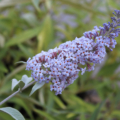Description
Buddleja officinalis | Pale Butterfly Bush
Pale Butterfly Bush, also known as Pole Butterfly Bush and Mi Meng Hua, is a deciduous to semi-evergreen early-spring flowering shrub endemic to west Hubei, Sichuan, and Yunnan provinces in China. It was discovered in 1875 by a surgeon in the Russian army, and was introduced to western cultivation in 1908.
Pale Butterfly Bush resembles very closely that of the more common and invasive Buddleja davidii with honey-scented, pale-purple, periwinkle to mauve-moonlight colored flower panicles that are a bit shorter and more conical. However, unlike B. davidii, B. officinalis is not fully frost hardy and benefits from a protected spot in the winter. Very rare in cultivation.
Grows naturally on forest edges, cliffs, scrub and waste places, and thickets along riverbanks.
B. officinalis was accorded the Royal Horticultural Society’s Award of Merit in 1911 and the Award of Garden Merit in 2002.
Type: Perennial
Sun exposure: Full sun
Mature height: 10-12 ft
Mature width: 6-8 ft
Hardiness zones: 9-11
UNROOTED CUTTINGS:
- Price is for five cuttings (5)
- Each cutting is 4-9 inches long. May be single top or multi-top.
- Guaranteed to be green, healthy, and alive. Plus pest and pathogen free.
- Guaranteed to be true-to-name.
- Please only order unrooted cuttings if you are familiar and comfortable with rooting plants
- If it’s believed the plants are not alive and healthy when you receive them you must let us know any concerns you have within 24 hours of arrival. If we do not hear any concerns within 24 hours it will be assumed that everything arrived in good standing. We cannot be held responsible for mishaps, errors, mistakes, or bad luck after this time frame.
ROOTING INSTRUCTIONS:
How to prepare cuttings to root via rooting cubes inside a humidity dome.
- Upon arrival, give cuttings a new fresh cut on the bottom of the stem. Then set in a cup of water for a minimum of 15 minutes.
- After soaking, gently cut or scrape small marks into the bottom portion of the plant stem (½ inch) with scissors or a razor blade.
- Dip the scarred end of the stem into rooting gel or rooting powder. This can be done without rooting gel, but results are not as good.
- Insert the plant stem into a rooting cube (Oasis cubes, grow plugs, soil-cubes, rock-wool cubes, etc) and place into a nursery tray with a humidity dome over the top. One cutting per cube. Custom individual humidity domes can be made using plastic cups and/or plastic cling wrap.
- After the first 3-5 days, the humidity dome should be opened up or set ajar to slowly allow more air in as the plants start to root. At this point, the cubes should be allowed to become mostly dry before adding any more water.
- Once 2-3 roots grow out of the bottom of the root-cube, the plant can be transplanted into soil.
- More detailed rooting instructions will accompany your order.
We ship plants orders out on Mondays and Tuesdays only.














